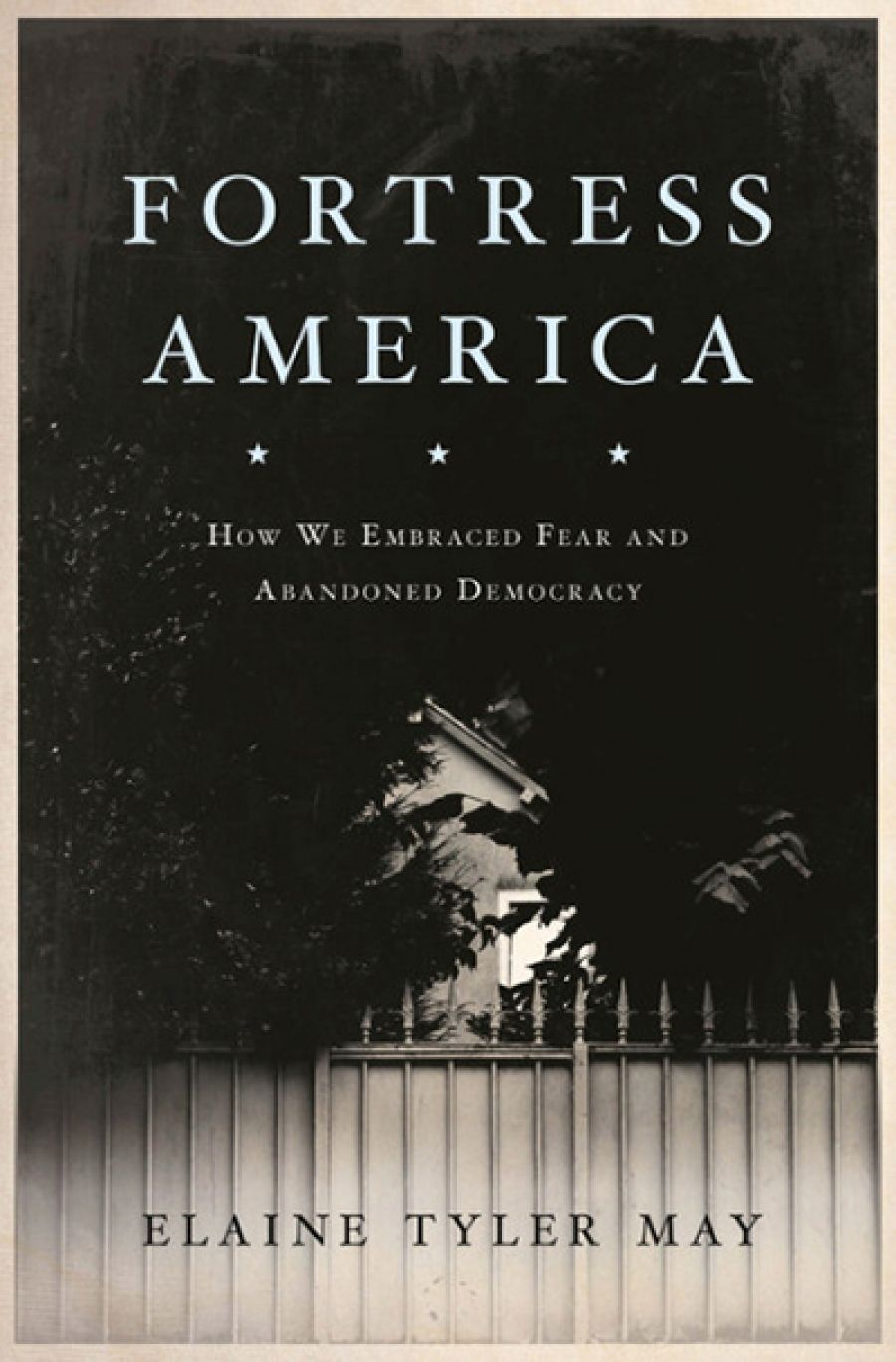
- Free Article: No
- Contents Category: United States
- Custom Article Title: Max Holleran reviews 'Fortress America: How we embraced fear and abandoned democracy' by Elaine Tyler May
- Review Article: Yes
- Online Only: No
- Custom Highlight Text:
On a Saturday afternoon shortly before Christmas in 1984, Bernhard Goetz was riding the New York City subway. Goetz, who is white, was approached by four black screwdriver-wielding teenagers who asked him for five dollars. Goetz drew a 0.38 pistol from his jacket and shot each of the boys once, then turned to one of them ...
- Book 1 Title: Fortress America
- Book 1 Subtitle: How we embraced fear and abandoned democracy
- Book 1 Biblio: Basic Books, US$30 hb, 256 pp, 9781478920274
Since the Goetz shooting, the United States has become much safer, with crime plummeting in nearly every city. Yet, gun ownership is even more sacrosanct, private security is flourishing, nearly ten per cent of the population live in gated communities, and fear pervades every aspect of contemporary American culture: from nanny cams to hysteria over border-jumping ‘rapists’ and ‘murderers’. Elaine Tyler May, in her new book, Fortress America: How we embraced fear and abandoned democracy, explores how the United States got to this point of paranoia and how Americans made themselves prisoners in a world where security precaution is not just an industry but a lifestyle.
From bunker-builders to zombie apocalypse preparedness groups, it can be easy to find mirth in American paranoia. However, May urges us to understand how this strain of thought is eroding the most basic social fabric of communal trust as well as having a devastating psychological impact on people who ponder school shootings, home invasions, and total social breakdown as if they were breakfast choices. May traces the development of this culture of fear from the onset of the Cold War to the ‘war on terror’, chronicling the suburban segregation, mass incarceration, and the militarised police that came along the way. She also adds a powerful gender dimension to the familiar story of America’s descent into fantasies of perpetual danger: it was only with the disruption of the nuclear family of the 1960s – and the reactionary reassertion of masculinity which followed – that fear came to dominate US culture.
During the 1960s the Cold War led not just to duck-and-cover drills, municipal fallout shelters, and the widening of suburban streets to allow for military vehicles to pass but an increased understanding that the home was under threat from the Soviet Union as well as from shifting racial, political, and gender norms. May shows that the Leave It to Beaver suburban aesthetic was not so much a reflection of the times as a desperate attempt to freeze domestic life in the immediate postwar era without the complications of women entering the labor force, declining marriage, and increasing rates of divorce. ‘As the family faced new challenges, the home itself became a site of vulnerability. Houses that once provided protection became places that needed protection. Homeowners transformed their houses into barricaded fortresses with alarm systems, metal grates, fences, and locks.’ The architecture of fear was not just to keep out the world but to buttress the nuclear family from internal disruptions.
After the outbreak of urban riots in the late 1960s, fear quickly shifted from ‘red to black’, with police forces increasingly using some of the same military hardware from Vietnam in places like Watts, Newark, and Detroit. Two decades later, the rhetoric had intensified: politicians and criminologists diagnosed a scourge of ‘super predators’ at the same time as Ronald Reagan eroded general trust in the government. This led to an explosion in the DIY protection industry, a field increasingly represented in media depictions of rogue men determined to hunt down those who threatened their family and deliver vigilante justice as police and prosecutors dithered. The American male in search of rough justice comes from a cowboy legacy but it has been well marketed to suburban dads who want to simultaneously live in high-walled McMansions while celebrating their own agency as masters of self-reliance. However, gates are not just about protection. With other aspects of the Reagan era, they represented the privatisation of everyday life: prep schools, gated neighbourhoods, private security, and even pension reform. As people guarded their assets and families more fiercely, they also divested in state programs meant for the public good.
 Minnesota 'March for Our Lives', March 2018 (Flickr)
Minnesota 'March for Our Lives', March 2018 (Flickr)
The irony that May captures is that Americans have more to fear now than they ever have: they are just fretting over the wrong things. The country is economically unequal to the point of near uprising, the infrastructure of the world’s richest country is in tatters, and climate change, ignored or mocked by many Americans, will drastically reshape life in the next century. Especially after the 2008 financial crisis, fear of a statistically unlikely home invasion compared to a far more likely predatory mortgage default is highly misplaced: ‘While citizens were distracted by street crime that harmed relatively few people, unregulated private enterprise and a rapidly widening gap between the very wealthy and everyone else were at work producing profound insecurity for millions of Americans,’ May points out. One would think that fear could have a potential unifying effect, but not in individualistic America.
Early in the book, May recounts a Twilight Zone episode in which a doctor and his wife deny their neighbours entry into their private shelter during a nuclear attack (later revealed to be a false alarm); she ends by describing a new bunker for billionaires, of which the crucial architectural element is a sniper’s nest.


Comments powered by CComment